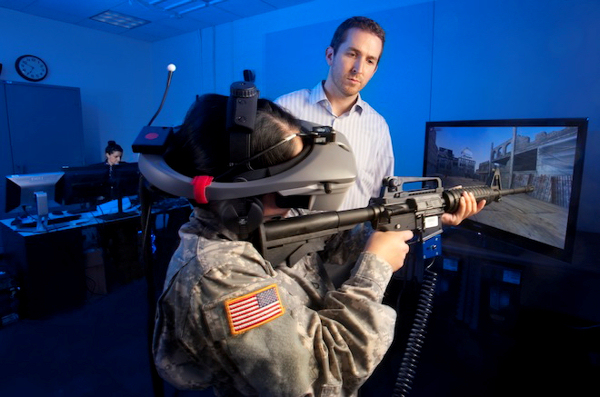[From Wired magazine’s Danger Zone blog]
[Image: U.S. Department of Defense]
Army’s Virtual Reality Plan: A Digital Doppelganger for Every Soldier
By Katie Drummond
January 18, 2012
The Army wants soldiers of the future to be all they can be — onscreen and off.
As the military’s enthusiasm for virtual reality training continues to grow, the Army’s got a new plan to make the programs freakily immersive: National Defense magazine is reporting that the Army wants to give every soldier a digital doppelganger — a custom avatar they can use throughout their stints in the military, and in myriad virtual training environs, from urban combat practice to cultural prep.
“You design an avatar that has the individual facial features of a soldier,” James Blake, the Army’s program executive officer for simulation, training and instrumentation, tells National Defense. “Then you add more of what he looks like, physical attributes. When you’re in your game environment, you’d like to have the physical and mental attributes of that individual reflected in that virtual world.”
But the avatars would be much more comprehensive than simple lookalikes. A soldier’s performance during physical training, for example, would be inputted into the digital replica’s athletic abilities. So unlike super-charged videogame operatives, soldiers who huff and puff running an 11-minute mile won’t see their avatars do much better. Likewise, soldiers with crappy real-life shooting skills will be liabilities to their virtual units during group training sessions.
Given the rate at which virtual reality has become embedded in military life, it’s only a matter of time before digital environments act as an ultimate second life for soldiers. Already, military personnel do everything from immersive combat training to cultural sensitivity coaching via videogame. The Army’s even after one massive, “whole virtual world” where soldiers can meet up and train.
But virtual training, custom avatars or not, will always have its limits. In particular, as Danger Room pal Peter Singer wrote in 2010, the method threatens to churn out soldiers who are seasoned pros on the Xbox — but aren’t cut out for the rigors of real-world war. ”At some point, piloting a plane in combat is different from piloting a computer workstation,” Singer noted. “Just as hitting a real tennis ball is not the same as hitting the Wii version.”
At the very least, the Army’s avatar initiative would remind soldiers that real-world progress does matter: They want to continually upload advances an individual makes in reality, like acing a fitness test, into that person’s avatar.
Indeed, if virtual reality is where the Army’s training is headed, then more realistic avatars makes sense. The last thing soldiers need, before deploying to a real-life combat zone, is the impression that they’ve got mad superhero skills. Digital avatars that behave and evolve more like real people, flaws and all, could actually remind recruits that they’re fighting flesh-and-blood wars. Which, unfortunately, don’t come with a reset button.
